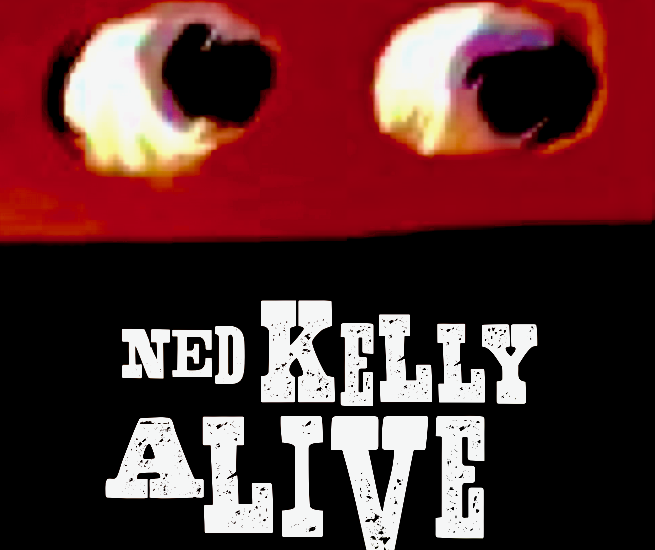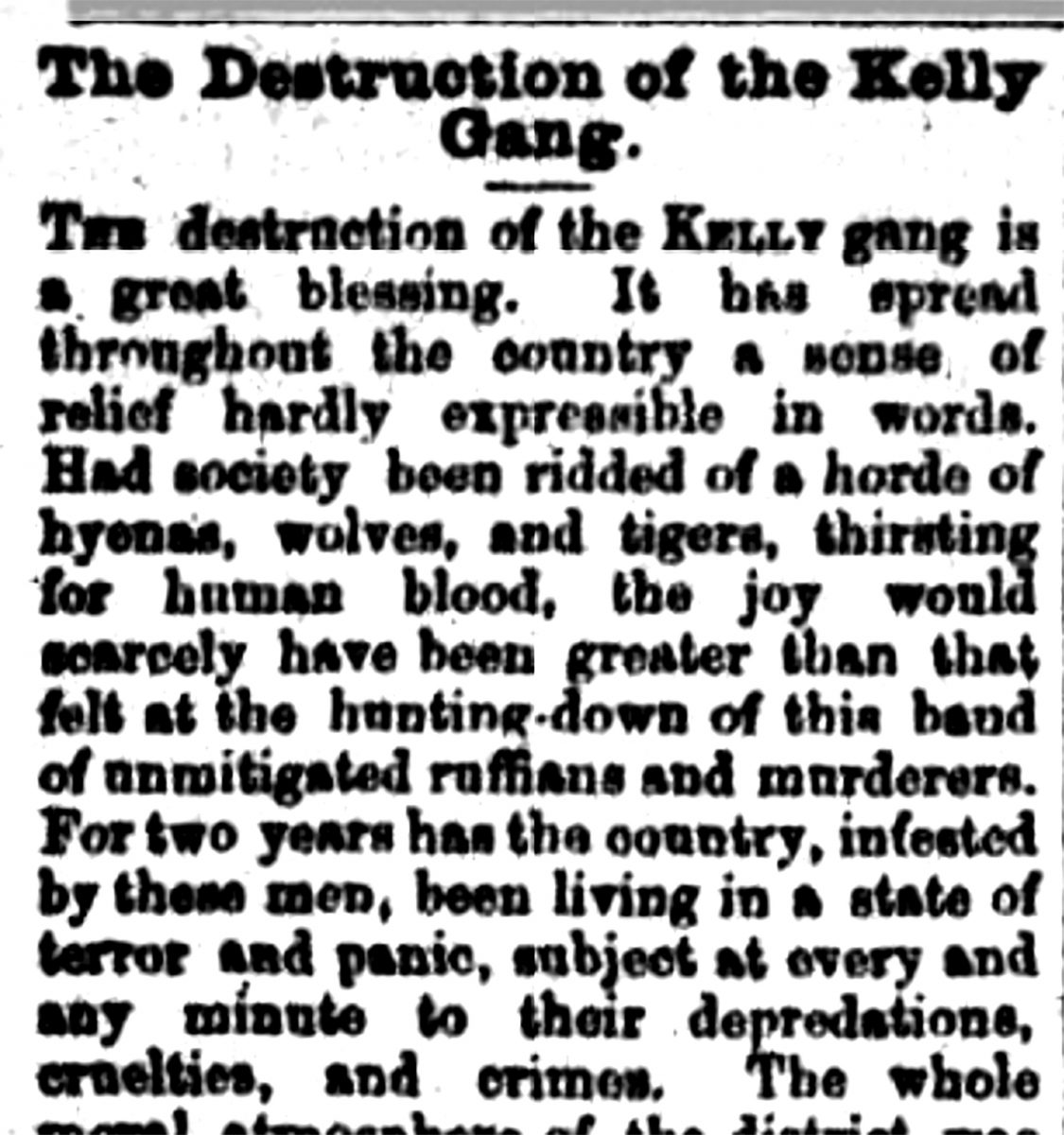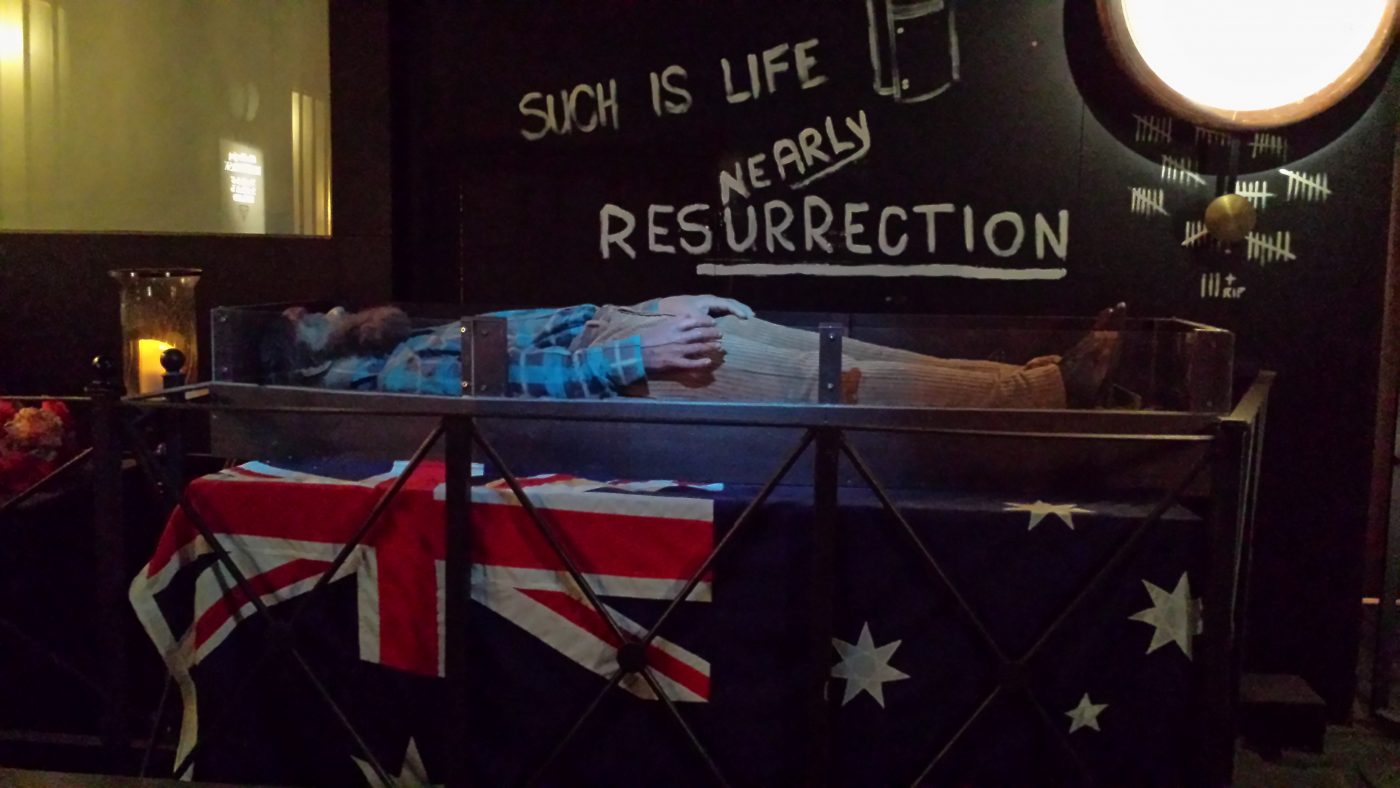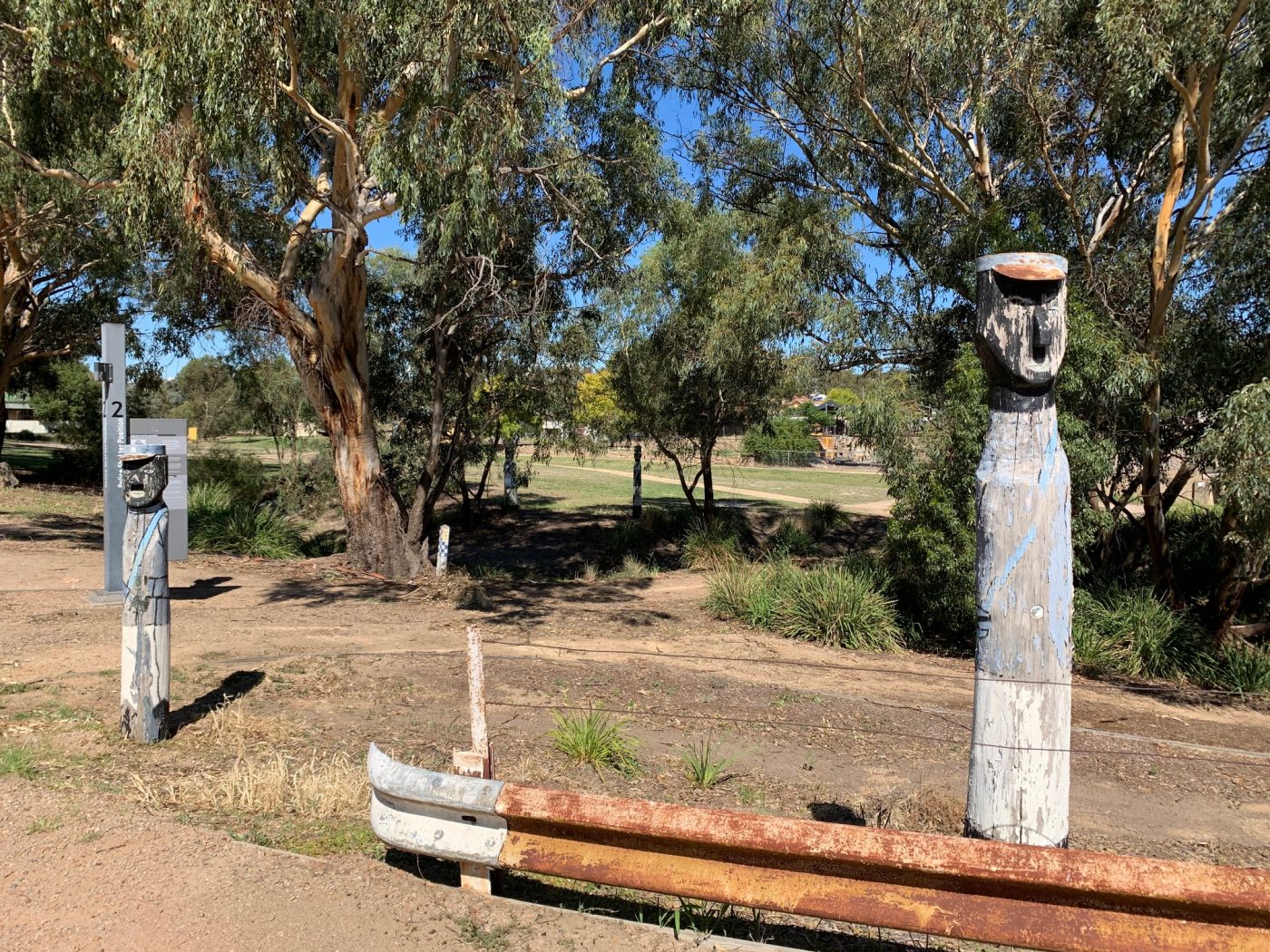The upcoming Ned Kelly Alive projects for North East Victoria are a crossroads for the Kelly story. The important decision the content creators for these projects have to make at an early stage is whether or not they are going to use their modern technology and creativity to tell the same old story in the same old way – you know ‘Ned Kelly – hero or villain – you decide’ – or are they going to be bold and demonstrate leadership and take the story into the 21st century?
The important challenge the NK Alive team has to confront is that in Victoria’s North-east, so called Kelly country, the Kelly narrative supported and promoted almost everywhere is outdated and unhistorical. Modern scholarship of the Kelly story over the last decade or so has overturned many of the claims that were made for it fifty years ago, and the only way the story can now be told with integrity is for those changes to be acknowledged and incorporated into any new Kelly narrative. It would be dishonest to promote a false and outdated version of history. It would also be embarrassing for the region as well as a waste of taxpayer money to be promoting and supporting as Australian history stories known to be untrue.
The second challenge facing the NK Alive developers is that there seems to be a fear among community leaders and Council members that unless Ned Kelly is portrayed as some sort of downtrodden working class hero who was pushed into violent rebellion against authoritarian persecution, nobody will be interested in him and the Tourist Industry that is supported by that mythology will collapse and everyone will be out of work.
But nothing could be further from the truth: all round the world people are endlessly fascinated by crime and criminal minds and personalities as evidenced by the popularity of innumerable TV crime series, podcasts, movies and novels. Whether it be grisly murder, hostage taking, shootouts, cattle rustling, violence and mayhem, the rivalry between the Law and the Outlaw… the Kelly story has it all. There’s a criminal dynasty, a famous matriarch, murders and violent assaults, sex scandals, death in childbirth, hostage taking, domestic violence, ambush, arson, great Court scenes, rivalries and jealousies inside the institutions, bravery and cowardice, the town against the bush, rich versus poor, arson, even quite horrific animal cruelty, and the very worst and the very best of human behaviour. All that and more is all there in the story. There is such a richness of material to work with, only an incompetent would be unable to create hugely entertaining, fascinating and informative tourist experiences out of it.
So where should the NK Alive developers start, in trying to understand and develop out of all the conflicting claims, a modern Kelly narrative thats historically accurate? For someone who may not be all that familiar with the detail but is about to spend hundreds of thousands of taxpayer dollars on telling the story of the Outbreak, I would say a good place to start is with Ian Jones, because he is the man who more than anyone is responsible for creating the Kelly story that’s been dominant for the last fifty years.
Historically, for most of the century that followed Ned Kellys death in 1880 he was regarded almost universally as a violent but colourful and innovative criminal, but a criminal never-the-less. However, in his acclaimed biography ‘A Short Life’ Jones set out his ‘new view’ of the outbreak, an idea he first espoused publically in 1967, and which then became the version of the Kelly story that’s been dominant for most of the last fifty years. Here the Kelly family are portrayed as one of many poor persecuted selector families in a north-east Victoria that’s racked by social unrest, battling for survival against powerful squatters in concert with corrupt police and judiciary. In Jones view, social unrest eventually gets to the point that a local small-scale rebellion emerges out of selector oppression, its led by Ned Kelly who proposes to found an independent republic in the north-east but his attempt to do so with the help of a small selector ‘Army’, ends in disaster, at Glenrowan. Here some sort of war was supposed to break out but instead Kelly was captured at ‘the last stand’, the other members of the Kelly gang were killed, the ‘Army’ melted away and a few months later Ned Kelly aged 25, was hanged.
It’s a great story told that way, and many were convinced by Jones telling of that same narrative in the 1980 TV Miniseries ‘The Last Outlaw’., a series still mentioned in Kelly supporter circles as the best film version ever produced.
However, the transformation of Kelly from a criminal to a rebel-with-a-cause depends entirely on Jones being right about the Republic, and he knew it. He wrote:
“The Glenrowan campaign is inexplicable without the central carefully obscured fact of the republic”.
At another place, Jones described the Glenrowan Campaign as ‘madness’ unless it was part of a fight to establish some sort of new political order. He went so far as to say that if Glenrowan wasn’t ‘an act of war’, then it would be ‘simply mass murder’. In 1992, in his other major work ‘The Fatal Friendship’ he wrote of Glenrowan that it “demanded some such rationale or it would be seen simply as a criminal atrocity of monstrous scale”
By 2021, more than fifty years after Jones ‘new view’ was formulated and installed as the orthodox Kelly story, newer scholarship and careful research has shown there is no historical basis for Jones ‘New View’ of Kelly and Jones idea of a Kelly republic has been completely discredited. There was no such thing. This means of course that without it, the original understanding of Kelly as a criminal is restored, and therefore, to use Jones own words, what Kelly planned for Glenrowan has to be regarded as ‘simple mass murder‘ and a ‘criminal atrocity of monstrous scale’ . Until Jones pushed those ideas to one side, they were the descriptions that had always been used to describe what was planned for Glenrowan – the story has simply returned to its roots.
There are many other components of Jones “New View” that have been successfully challenged and overturned in recent years, such as a realisation that Kelly lied about the killing of Lonigan at Stringybark Creek, a critical analysis of his likely personality disorder and an alignment of the historical sources that strips away the accumulated unhistorical claims made about the central role of Fitzpatrick and other police in the story.
So, to bring themselves up-to-date on the evolution of the Kelly story in recent years the NK Alive team needs to do a lot more than just read Jones book and consult with Kelly spokespeople in Victoria, most of whom will be committed to the now outdated ‘New View’ from 1967. They need to become familiar with the works of Ian MacFarlane from 2012, and those of Dawson, Kieza and Morrissey in the last five years or so. These writers revelations and insights have raised the ire of Kelly supporters but there hasn’t been one serious word of refutation of any of it from anyone. Already though, some Kelly supporters have started to move away from the central Kelly theme of a Republic but nobody has found anything to replace it with, other than the plan Kelly himself wrote of, a somewhat confused plan which was purely criminal and aimed at robbing banks freeing his mother from prison.
The reality of the Kelly story is that it is a unique and fascinating crime story, peopled with all kinds of colourful and sinister as well as admirable characters, set in a rich and beautiful part of the country. But at the proposed Tower in Glenrowan, the story there can no longer be of a failed revolution but of an attempted ultra-violent ‘criminal atrocity of monstrous scale‘, mass murder on a scale that would have placed Kellys image in the same category of monster as the Christchurch Mosque killer. This ghastly truth about what was in Ned Kellys heart should no longer be concealed.
What the NK Alive team are going to have to do, if they plan to tell an accurate historically verifiable account of the outbreak is persuade the north-east that telling the true story wont destroy their tourist industry even if some of the myths have to be let go in the process. It won’t be an easy task, but its an enormous and exciting opportunity to radically rewrite and restore accuracy and honesty to the history of the north east, to do an about face and reorientate the story from one based on fantasy to one based on historical fact.
To be honest I think they won’t be brave enough to try. My fear is that they will take the path of least resistance along with their hefty contract payments and make only token references to alternative points of view, and do their best not to upset the apple cart. Lets see what happens.

I think what happened is that most people are unknowingly trapped in Jones’ dominant narrative, which as you say began with his highly inaccurate 1967 ‘New View’. His 1995 ‘Short Life’ and its subsequent editions continued the historically error-ridden and highly romanticised outlook that he had put forward in 1967, which was – as McQuilton noted – ridiculed by academics at the time. Most people don’t have the time or critical training to see how Jones’ ‘Short Life’ is a house of cards built on highly selective references and quotations, misquotations of references, manipulation and misrepresentations of source documents, outright fabrication and invention presented as facts, and direct contradiction and/or silent ignoring of evidence in source documents that doesn’t suit his narrative. It is not remotely a comprehensive presentation of the evidence on any single topic in the book. It is a powerfully written historical fiction from a master storyteller and professional scriptwriter – but it is far from a factual account of Kelly. It also misses chunks of his life – Jones says nothing about Kelly’s time on a hulk, and hides his criminality during what Jones called his three “quiet years”. Narrative conveys stories no matter how inaccurate, and as yet there is no comprehensive counter-narrative to Jones, despite a number of recent studies exposing gaping holes in his tale of mystery and imagination.
Kelly’s irrelevance to Australian history by the end of the nineteenth century is seen in books like “Diary of a Welsh Swagman” 1864-1889, in which the Kelly gang get half a page about their well-earned downfall; “Sketchbook of Victoria” (1886: 156-157) in which they get a condemnatory page and a half in the context of describing the countryside from Euroa to Mansfield; and in a chunky 1960s Australian biographical dictionary which I can’t locate just now in which Kelly is not listed at all.
Not until Kenneally’s 1928-29 “Inner history of the Kelly gang” was there anything that attempted to justify the gang’s exploits. Written by a near neighbour of Mrs Kelly, and informed by the selective tales of Tom Lloyd Jr, Kenneally wrote what he hoped would be a vindication of Kelly, a man set upon by the “loaded dice” rolled against him by of police and the judicial system. Kenneally was a master of selective quotation, especially from the Royal Commission Minutes, and equally a master of not mentioning anything that cast Kelly in a bad light. A J.P. himself, he seemed to think that Kelly had not been treated fairly and with justice; and yet, as David has pointed out numerous times on this blog, and as the Royal Commission saw at the time, there is no evidence anywhere for the idea that the Kellys were persecuted, and much evidence to the contrary, i.e. that they and their clan were often given the benefit of the doubt by the courts, hence the frequent dismissals of charges against them. Max Brown contributed the hero myth, seeing Kelly as a rugged Australian rebelling against the fat old English Queen Victoria, which says more about Brown’s Australian socialism that it does about Kelly. Jones admired both of these narratives, and took from them much that he should have critically evaluated rather than followed. He also took from them a distain for source evidence that contradicted his narrative, hence the greatest weakness and bias in his own writings. One sometimes thinks that Jones himself knew he was writing purely speculative unsupported narrative to see if he would get away with it. After all, a New View requires a leap of imagination, so why not just keep imagining using selective referencing, and see how well it hangs together by avoiding or twisting contradictory facts?
Gullibility regarding oral history is another of Jones’s great weaknesses. So many of his references turn out to be something someone told him, no doubt with prompting, as with the nonsense about the republic myth exposed in my free book. This ludicrous fiction, aired in 1967 and expanded upon over the years based on no evidence whatsoever (and a great deal to contradict it), was also indebted to Leonard Radic’s one-time but later retracted belief that he had seen a printed declaration document in London, a claim that sucked in numerous legal eagles, most notably Chief Justice John Phillips. The whole republic myth was built on later retracted statements by the ex-policeman son of Tom Lloyd Jr, who told both Doug Morrissey and Leo Kennedy that he had made up republic nonsense to make fools of the Kelly researchers Ian Jones and John Molony, both of who fell for his deliberately contradictory tales. (See my Republic Myth download book for details.)
Kelly remained the province of amateur historians until 2012, when Ian MacFarlane released his ground-breaking and meticulously referenced “The Kelly Gang Unmasked” (Oxford Uni Press), which blew apart many of Jones’s and others’ fabrications. It was around that time or a little earlier that I started looking at Kelly for the first time, and was struck by how unlikely Jones’s presentation of both the Fitzpatrick incident and the republic tale seemed in his ‘Short Life’. As someone who had spent time looking at the Australian nineteenth century Mechanics’ Institutes movement and related colonial history, what Jones was saying about a Kelly republic seemed preposterous. So I went from there, and sure enough, Jones’s work was a joke. Yet how widely believed! I remember discussing it with the then head of Monash Uni rare books, who said that Kelly history was written by amateurs and I should have no trouble getting published and making waves. And so it was, although it required a huge amount to time and work.
As to whether the Ned Kelly Alive people will pay any attention to the critiques of Jones’s writings, by a bunch of us who have done serious work on Kelly history since 2012, the question is really are they capable of doing that, or are they prisoners of Jones’ narrative and its influence. Remember that practically every non-fiction book on Kelly since 1970 has thanked Jones for his personal discussion and comments. He has inserted his narrative in other’s work for over 50 years. Corfield’s Encyclopaedia is just one example among dozens. Many people wanting to write about Kelly got in touch with Jones, and he was happy to oblige. That’s why his narrative seems ubiquitous, because it is. But it is wrong in many places including the most significant, as a group of us critical scholars have shown. Can the Ned Kelly Alive consultants get with the program, or are they unwittingly trapped in Jonestown waiting for a factual massacre after spending buckets of government money on a sham Kelly narrative? I am a little more optimistic that some balance might prevail, but it requires the rigorous rejection of most of Jones’ 1967 New View and its legacy, and I am not sure they and their timeframe will be up to it. But I hope so. If they end up producing an unhistorical fiction, the project will be mercilessly pilloried as it ought to be. And the controversy over numerous egregious errors such as Jones (and Molony) propagated for years will be well deserved. They need to get it right.
Attachment
I hope the Kelly tourism promoters and consultants are reading these comments and paying close attention…
Will Glenrowan spring to life? Can Ned get a head? Can we Steele ourselves for another mis (ad)venture? Will the Kelly myth limp on lamely, like Ned to the scaffold?
If Ned came back today, what would zir pronouns be? I wonder…
Attachment
Whoever runs Glenrown tourism gave up long ago. I took this photo at the end of February this year. All the so-called story posts around the siege area are the same – faded out years ago. No-one cares. The only people trying to get councils to spend up on Kelly in Glenrowan seem to be those who personally stand to make a buck out of it. Anyone who actually cared even remotely about the Glenrowan Kelly story could have repainted three or four of these poles in an afternoon, good as new and at little cost. But they have been left to fade and rot, symbolic of the total lack of interest there. Plus, quite a few people around there are happy to let the Glenrowan tragedy fade into the distant past and be forgotton. Kelly nuts like to think the “Glenrowan story” is something worth preserving; but they only know the hero-Jones version.
Plenty of descendants of the Kelly victims would be quite happy to never hear of Kelly again except in an extremely perjorative way. Three such people have told me so. No names thank you, and there are plenty more non-descendants around whose family histories have only bad things to say about the Kelly gang. These people are in the clear majority, not that you’d know it from reading drivel by a tiny group of very loud but badly read enthusiasts. There are of course a few well-read enthusiasts and descendants, but again, these are a small bunch, some of whom can’t stand various others of their general outlook.
Given the lack of communications from the Kelly Alive Project in the last 2 months, I am starting to fear that they will go along with the dominant flawed Jones narrative with all its badly bungled history, but I just have to wait and see like everyone else. As you say David, they have an oppotunity to set the story straight in the light of much significant rigorous criticism of Jones’s myths over the last 10 years or so. But will they?
Attachment